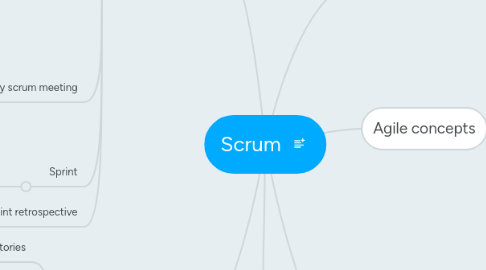
1. Artifacts
1.1. User Stories
1.1.1. As a (role) I want to (feature) so that (benefit)
1.1.2. Subdivided if too large
1.2. Product backlog
1.2.1. List of User Stories
1.2.2. Wish list of all the things that would make the product great
1.3. Release backlog
1.3.1. List of User Stories for a specific release
1.3.2. Prioritized and estimated tasks
1.3.2.1. Estimates
1.3.2.1.1. Story points
1.3.2.1.2. Hours
1.4. Burndown chart
1.4.1. Burndown Velocity
1.4.1.1. Estimate when the project will end
1.4.1.2. Make adjustements to finish on time
1.4.2. Day by day mesure of work
1.5. Daily scrum meeting
1.5.1. 15 minutes every day
1.5.1.1. What have I achieved?
1.5.1.2. What are the obstacles I found?
1.5.1.3. What I plan to do?
1.5.1.4. Helping others find solutions
1.6. Sprint
1.6.1. The realisation of release backlog activities
1.7. Sprint retrospective
1.7.1. Reflection of what went right and what went wrong
2. Process
2.1. 1. Create User Stories
2.2. 2. Create Product backlog
2.3. 3. Create a Release backlog
2.4. 4. Create a sprint, and a sprint backlog
2.5. 5. Every day, scrum meeting, and burndown chart update
2.6. 6. Release the sprint
2.7. 7. Sprint Retrospective
2.8. 8. Go back to 3
3. Concrete Application to the project
3.1. Using the scrum process
4. Introduction
4.1. Definition
4.1.1. A way to manage a project
4.2. Comparison with other methodologies
4.2.1. Release planning
4.2.1.1. Create release backlog
4.2.2. Uses sprints
4.3. Agile manifesto
5. Agile concepts
5.1. Faster
5.2. Don't need much documentation
5.3. Small teams
6. Roles
6.1. Product owner
6.1.1. Sets the direction of the project
6.2. Scrum Master
6.2.1. Make sure the project is progressing
6.2.2. Tasks
6.2.2.1. Monitoring tasks being done
6.2.2.2. Sets up meeting
6.2.2.3. Facilitate release planning

